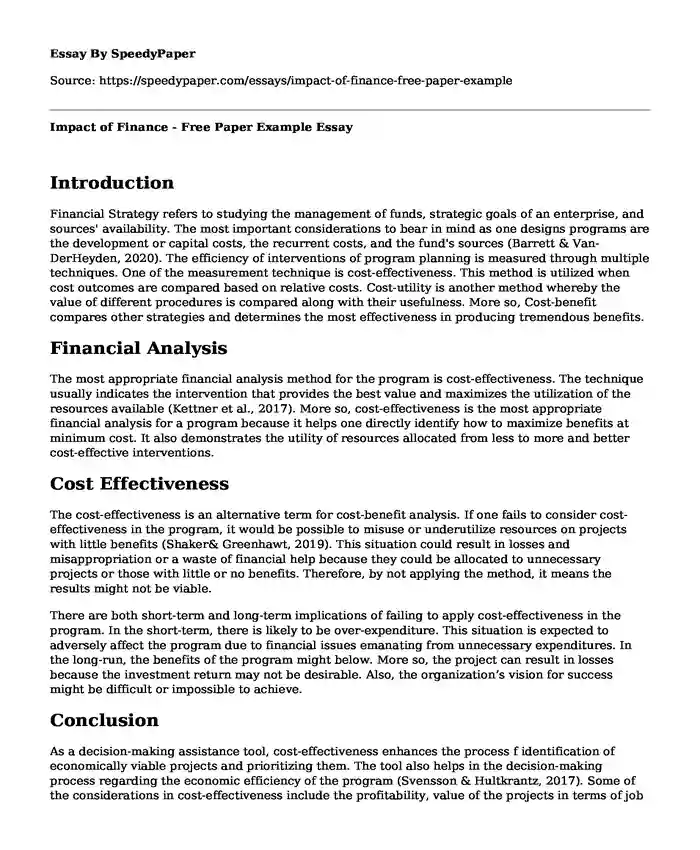
| Type of paper: | Essay |
| Categories: | Financial management |
| Pages: | 2 |
| Wordcount: | 539 words |
Introduction
Financial Strategy refers to studying the management of funds, strategic goals of an enterprise, and sources' availability. The most important considerations to bear in mind as one designs programs are the development or capital costs, the recurrent costs, and the fund's sources (Barrett & Van-DerHeyden, 2020). The efficiency of interventions of program planning is measured through multiple techniques. One of the measurement technique is cost-effectiveness. This method is utilized when cost outcomes are compared based on relative costs. Cost-utility is another method whereby the value of different procedures is compared along with their usefulness. More so, Cost-benefit compares other strategies and determines the most effectiveness in producing tremendous benefits.
Financial Analysis
The most appropriate financial analysis method for the program is cost-effectiveness. The technique usually indicates the intervention that provides the best value and maximizes the utilization of the resources available (Kettner et al., 2017). More so, cost-effectiveness is the most appropriate financial analysis for a program because it helps one directly identify how to maximize benefits at minimum cost. It also demonstrates the utility of resources allocated from less to more and better cost-effective interventions.
Cost Effectiveness
The cost-effectiveness is an alternative term for cost-benefit analysis. If one fails to consider cost-effectiveness in the program, it would be possible to misuse or underutilize resources on projects with little benefits (Shaker& Greenhawt, 2019). This situation could result in losses and misappropriation or a waste of financial help because they could be allocated to unnecessary projects or those with little or no benefits. Therefore, by not applying the method, it means the results might not be viable.
There are both short-term and long-term implications of failing to apply cost-effectiveness in the program. In the short-term, there is likely to be over-expenditure. This situation is expected to adversely affect the program due to financial issues emanating from unnecessary expenditures. In the long-run, the benefits of the program might below. More so, the project can result in losses because the investment return may not be desirable. Also, the organization’s vision for success might be difficult or impossible to achieve.
Conclusion
As a decision-making assistance tool, cost-effectiveness enhances the process f identification of economically viable projects and prioritizing them. The tool also helps in the decision-making process regarding the economic efficiency of the program (Svensson & Hultkrantz, 2017). Some of the considerations in cost-effectiveness include the profitability, value of the projects in terms of job creation, and other social benefits. Therefore, the overall outcome of cost-effectiveness is the project's viability and overall advantage compared to alternative programs.
References
Barrett, C. A., & Van-DerHeyden, A. M. (2020). A cost-effectiveness analysis of classwide math intervention. Journal of School Psychology, 80, 54-65.
https://pubmed.ncbi.nlm.nih.gov/32540090/
Kettner, P. M., Moroney, R. M., & Martin, L. L. (2015). Designing and managing programs: An effectiveness-based approach. Sage Publications.
https://www.amazon.com/Designing-Managing-Programs-Effectiveness-Based-Sourcebooks/dp/1412995167
Shaker, M., & Greenhawt, M. (2019). Estimation of health and economic benefits of commercial peanut immunotherapy products: a cost-effectiveness analysis. JAMA network open, 2(5), e193242-e193242. https://jamanetwork.com/journals/jamanetworkopen/fullarticle/2732333
Svensson, M., & Hultkrantz, L. (2017). A comparison of cost-benefit and cost-effectiveness analysis in practice: divergent policy practices in Sweden. Nordic Journal of Health Economics, 5(2), 41-53. DOI: 10.5617/njhe.1592.
Cite this page
Impact of Finance - Free Paper Example. (2023, Dec 25). Retrieved from https://speedypaper.net/essays/impact-of-finance-free-paper-example
Request Removal
If you are the original author of this essay and no longer wish to have it published on the SpeedyPaper website, please click below to request its removal:
- Essay Example on Classroom Management Plan and Model Classroom
- Free Essay Investigating Value Chain Configuration
- DC Micro Grid Financial Plan, Essay Example for You
- Free Essay: The Criticality of Operational Business Decisions Made Within the Game
- Paper Example. Importance of a Strong Company Culture
- Project Manager's Concerns in Developing a WBS with Software - Essay Sample
- Essay on Navigating Challenges in Project Management: Forming Teams, Project Selection, and Successful Closeout
Popular categories




